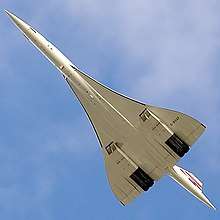Supercruise
Supercruise is sustained supersonic flight of a supersonic aircraft with a useful cargo, passenger, or weapons load performed efficiently, which typically precludes the use of highly inefficient afterburners or "reheat". Many well known supersonic military aircraft not capable of supercruise can only maintain Mach 1+ flight in short bursts, typically with afterburners. Aircraft such as the SR-71 Blackbird are designed to cruise at supersonic speed with afterburners enabled.
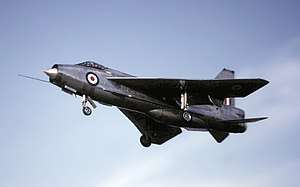
One of the best known examples of an aircraft capable of supercruise was Concorde. Due to its long service as a commercial airliner, Concorde holds the record for the most time spent in supercruise; more than all other aircraft combined.[1]
Advantages
The main advantage is the ability of an aircraft to fly at supersonic speed without using its afterburner which consumes large amounts of fuel and limits its range.
Supercruise capability also provides advantages for stealth aircraft, because an afterburner plume reflects radar signals and creates a significant infrared signature.[2]
History
On 3 August 1954, a Gerfaut research aircraft powered by an SNECMA Atar 101D2A engine exceeded Mach 1 on level flight without using afterburners.[3][4] The first production aircraft intended to exceed Mach 1 in dry level flight was the un-reheated Armstrong Siddeley Sapphire powered P.1 prototype of the English Electric Lightning, on 11 August 1954. A week previous, on 4 August, the P.1, WG760 flown by Roland Beamont on its maiden flight, had unknowingly exceeded Mach 1 in a climb, although, due to position error, the Machmeter had only shown a maximum of Mach 0.95. Beamont, who had not noticed any change in behaviour of the aircraft, was surprised when informed after the flight data had been analysed.[5] However, this early demonstration of supercruise was extremely limited, as the Lightning could only cruise without reheat at approximately Mach 1.02,[6] while later versions were able to achieve much higher speeds.
The BAC TSR-2 strike and reconnaissance aircraft, which first flew on 27 September 1964, was one of the first military aircraft specifically designed to cruise supersonically; one of the planned mission profiles was for a supersonic cruise at Mach 2.0 at 50,000–58,000 ft (15–18 km).[7] Supersonic cruise at lower levels was at Mach 1.1 at 200 ft (61 m).[8] The TSR-2 used Bristol Olympus engines, a later version of which would also power Concorde.
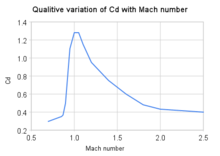
Only the supersonic transports (SST), Concorde and the last version of the Tu-144 (the Tu-144D), spent most of their time cruising at their design speeds without needing afterburning. Some combat aircraft that are listed as capable of supercruise may only be able to do so without an external weapons load, for example. Reheat was added to Concorde for take-off to cope with weight increases that came after the initial design. As it was available, it was also used for transonic acceleration to reduce the time taken and fuel used to reach cruise. The upgraded Tu-144D had more economical engines than the Tu-144, which did not require afterburners during cruise, as well as a more advanced intake design, which increased the full payload range from 3,080 to 5,330 km (1,910 to 3,310 mi) (Concorde's operational range was 6,470 km or 4,020 mi).[9]
Military use
The term "supercruise" was originally used to describe a fighter performance requirement set forth by USAF Col. John Boyd, Pierre Sprey, and Col. Everest Riccioni, proponents of the F-16 Falcon. Following the entry into production of the F-16, they began work on an improved fighter design with the ability to cruise supersonically over enemy territory for a minimum of twenty minutes. As air combat is often the result of surprise, and the speed of combat is determined by the speed of the surprising aircraft, this would have given a supercruise-capable design a worthwhile performance advantage in many situations. The postulated fighter would have had a top speed of just over Mach 1, and a fuel fraction in excess of 40%, the minimum required to meet the twenty-minute requirement. The fuel fraction requirement necessitated a very austere design with few advanced electronics. The United States Air Force showed no interest in the proposal at that time, but years later revived the term and redefined it to apply to the requirements for the Advanced Tactical Fighter,[10] which resulted in the F-22 Raptor.
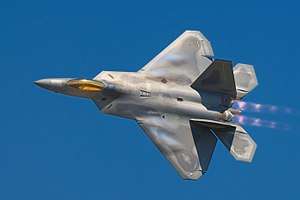

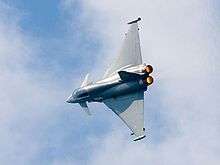
The F-22 Raptor's supercruise capabilities are touted as a major performance advantage over other fighters, with supercruise being demonstrated up to at least Mach 1.8.[13] Virtually all current and past jet fighters, prior to the F-22, cruise at approximately Mach 0.8–0.9 with militarily significant weapons loads.[14] However, supercruising uses more fuel to travel the same distance than at subsonic speeds, with the Air Force Association estimating that use of supercruise for a 100-nautical-mile (120 mi; 190 km) dash as part of a mission would cut the F-22's combat radius from about 600 nautical miles (690 mi; 1,100 km) to about 450 nautical miles (520 mi; 830 km). This reduction is unconfirmed because the altitude and flight profile are classified, as are most of the F-22's capabilities, but it is still far less of a reduction than would result from the use of afterburner.
There are a few engines in production that are designed to facilitate tactically significant supercruise:
- The two Pratt & Whitney F119 that power the F-22 Raptor make it the most capable supercruiser fighter aircraft in service. The F-22 Raptor can supercruise up to Mach 1.8 without external stores.[15][16] (Note: General Electric YF120 supercruise capable engines also powered an F-22 prototype during this fly off, but were not selected for production.)
- The EJ200 engine built by EuroJet Turbo GmbH mounted in the Eurofighter Typhoon. It is capable of supercruising at Mach 1.5 with an air superiority missile load.[12] Typhoon pilots have stated that Mach 1.3 is attainable in combat configuration with external stores.[17]
- The General Electric F414G in JAS 39 Gripen NG is designed for supercruise and has been shown to achieve Mach 1.2.[18]
- The Snecma M88 that power the Dassault Rafale. The twin engines enable the Rafale to supercruise with four missiles and a belly drop tank.[11]
- The two AL-41F-1S engines of the Sukhoi Su-35 can achieve supersonic speed without engaging afterburners.[19]
Independently, Russia is working on Izdelje 30 (after AL31F and AL41F derivatives modifications, like 117S turbofan) and RD33MKRU Morskaja Osa; an all new AL-41 engine with a complete redesign underway to add supercruise ability to the Sukhoi Su-57. This has yet to bear fruit, but the stop-gap 117S engine, produced by this program, seems to achieve the supercruise goal already. It was recently announced that during testing of a Su-35BM fighter equipped with these engines it was travelling at just past supersonic speed it continued to accelerate without the use of the afterburner, thus suggesting that it had supercruise capability, though it has yet to be seen whether this will be possible with a combat load.[20]
All known supercruise aircraft can only do so at considerable altitude (where the air is thinner and so offers less resistance), which restricts the use of terrain mask for eluding detection.
Aircraft designed to cruise on afterburner
The Lockheed A-12, SR-71 Blackbird, and YF-12, were designed for sustained operation at supersonic speeds using an afterburner. SR-71 missions flew at maximum range cruise, with afterburner settings in the lower portion of the range, about 98% of the time.[21]
The North American XB-70 Valkyrie used six General Electric YJ93 engines for sustained flight at Mach 3.0, its design point.[22] Unlike the J-58 engine in the SR-71, the YJ93 did not need special fuel, as it used JP-6.[22] Partial afterburner was used for cruise.[23] The XB-70A AV-2 prototype sustained speeds in excess of Mach 3 for 32 minutes on one flight. The type was designed to operate at its design point speed for periods of hours over intercontinental ranges.[24] At 100% military thrust, at 35,000 ft (11,000 m), the XB-70 would exceed M1.03 so long as its mass did not exceed 400,000 lb (180,000 kg), rising to M1.2 as the mass dropped to 250,000 lb (110,000 kg)[25]
The Mikoyan-Gurevich MiG-25 was designed for supersonic cruise at Mach 2.35 with partial afterburner in operation. The engines used an extremely low pressure ratio of 4.75, but this was boosted by ram air pressure during supersonic flight.[26] The low pressure ratio of the compressor meant poor efficiency at subsonic speeds, and high efficiency at supersonic speeds.
The BAC TSR-2 was designed to cruise at M2.0 using afterburners, and had a predicted top speed of M2.35. It could also cruise supersonically without afterburner, as demonstrated on a delivery flight.[27][28]
Aircraft with supercruise ability
In service:
- Dassault Rafale[29]
- Eurofighter Typhoon[30]
- Saab JAS-39E Gripen[31][32]
- Lockheed Martin F-22 Raptor[33]
- Sukhoi Su-35[34]
- Sukhoi Su-57
Formerly in service:
- General Dynamics F-16N Fighting Falcon[35]
Prototype/experimental only:
- BAC TSR-2[27]
- English Electric Lightning prototype[36]
- General Dynamics F-16XL[37]
- Lockheed YF-22[38]
- North American XB-70 Valkyrie[39]
- Northrop YF-17[40]
- Northrop YF-23[38]
- Saab 35 Draken prototype[41]
Civilian:
References
- "Defence & Security Intelligence & Analysis - IHS Jane's 360". janes.com. Retrieved 2015-09-04.
- "Stealth design of airplanes / stealth aircraft". fighter-planes.com. Retrieved 2015-09-04.
- "The Development of Jet and Turbine Aero Engines" 4th edition, Bill Gunston, 2006, ISBN 0 7509 4477 3, p. 160
- "1956 - 0414 - Flight Archive". flightglobal.com. Retrieved 2015-09-04.
- "English Electric - Armstrong Siddeley - Rolls-Royce Avon - 1957 - 0541 - Flight Archive". flightglobal.com. Retrieved 2015-09-04.
- English Electric Aircraft and their Predecessors, Stephen Ransom & Robert Fairclough, Putnam, London, 1987, (p.227)
- "Image: tna-air2-17329e53a_02.JPG, (627 × 490 px)". nuclear-weapons.info. 2008-08-29. Retrieved 2015-09-04.
- "Image: ddSy1.jpg, (2711 × 1832 px)". i.imgur.com. Retrieved 2015-09-04.
- TUPOLEV Tu-144, Gordon, Komissarov and Rigmant 2015, Schiffer Publishing Ltd., ISBN 978-0-7643-4894-5, p.248
- The Cutting Age, p.141
- French Ministry of Defense Orders a Further 59 Rafale Fighters
- "Eurofighter Typhoon - Luftüberlegenheitsrolle - Austrian Eurofighter Site in German". web.archive.org. Archived from the original on August 15, 2009. Retrieved 2015-09-04.CS1 maint: unfit url (link)
- Ayton, Mark. "F-22 Raptor". AirForces Monthly, August 2008, p. 75. Retrieved: 19 July 2008.
- "Gallery of USAF Weapons", pp. 147–155. Air Force Magazine, May 2006.
- General Jumper qualifies in F/A-22 Raptor, af.mil, January 13, 2005
- Last of its kind. Flightglobal.
- "EuroFighter Typhoon". fighter-planes.com. Retrieved 2015-09-04.
- "Gripen Supercruises." Gripen International, 21 January 2009.
- "AL-41F-1C."
- "О ходе испытаний нового российского истребителя Су-35БМ: Наука и техника: Lenta.ru". lenta.ru. Retrieved 2015-09-04.
- "Flying the SR-71", Col. Graham, USAF (Ret.), ISBN 978-0-7603-3239-9, Zenith Press, 2008, p.132
- "B-70 Aircraft Study Final Report Volume III", April 1972, SD-72-SH-0003, Space Division, North American Rockwell
- "Variable-Geometry Exhaust Nozzles and their Effects on Airplane Performance" Ammer and Punch, General Electric Co., SAE 680295, Society of Automotive Engineers
- Jenkins, Dennis R.; Landis, Tony R.; White, Alvin S.; Fulton, Fitzhugh L. (2005). Valkyrie: North American's Mach 3 Superbomber. Speciality Press. p. various pages. ISBN 1-58007-072-8.
- T.O. 1B-70(X)A-1A Flight Handbook Supplement XB-70A page A5-4
- Soviet Spyplanes of the Cold War, Casemate, Yefim Gordon P.70
- Thornborough, Anthony. TSR2 (Aeroguide Special). Suffolk, UK: Ad Hoc Publications, 2005. ISBN 0-946958-46-7
- Losing an Empire and Finding a Role: Britain, the USA, NATO and Nuclear Weapons, 1964-70 K. Stoddart
- French Ministry of Defense Orders a Further 59 Rafale Fighters, p.8
- "Eurofighter Typhoon - Luftüberlegenheitsrolle". web.archive.org. August 15, 2009.
- "A Totally Superior Product" (PDF). Gripen News: 2. June 2001.
- "Gripen Supercruises" (press release). Retrieved 2009-12-04.
- "F-22 Raptor". U.S. Air Force.
- Karnozov, Vladimir (4 September 2007). "Sukhoi unveils 'supercruising' Su-35-1 multi-role fighter". Flightglobal. Archived from the original on 24 August 2013. Retrieved 24 April 2013.
- "What It Was Like Flying And Fighting The F-16N Viper, Topgun's Legendary Hotrod". Retrieved 2018-12-17.
- "lightning | 1963 | 0596 | Flight Archive".
- "F-16 Versions - F-16 XL". www.f-16.net.
- Stevenson, Richard W. (April 24, 1991). "Air Force Chooses Lockheed's Design for Fighter Plane" – via NYTimes.com.
- T.O. 1B-70(X)A-1A Flight Handbook Supplement XB-70A, p. A5-4
- Legacy of the Lightweight Fighter Competition, airforcemag.com, February 2017
- "Saab 35 Draken". Saab.com. 2015-12-14. Retrieved 2018-03-24.
At that time there was limited understanding of supersonic aviation, which is why the "double delta" configuration had been tested earlier in 1952 using the specially developed Saab 210 "Little Dragon" experimental aircraft. The maiden flight was carried out on 25 October 1955 by Bengt Olow and shortly afterwards, in January 1956, the Draken broke the sound barrier while climbing and without afterburner!
- Powerplant, ConcordeSST—describes full cycle of Concorde's engine from takeoff to touchdown, including the turning off of reheat to begin supercruise at Mach 1.7.
